Britain – a nation of tea drinkers and cake eaters….
In recent years TV shows such as The Great British Bake Off have lured us into the kitchen to try out our baking skills – I’ll bet there’s plenty a festive treat coming out of Britain’s kitchens in the run up to this Christmas…. Mince pies, Christmas cakes and puds, Yule logs – the Season wouldn’t be the same without them – so much a part of our traditional celebrations – but do we ever stop to consider why we eat such fare at this time of year….?
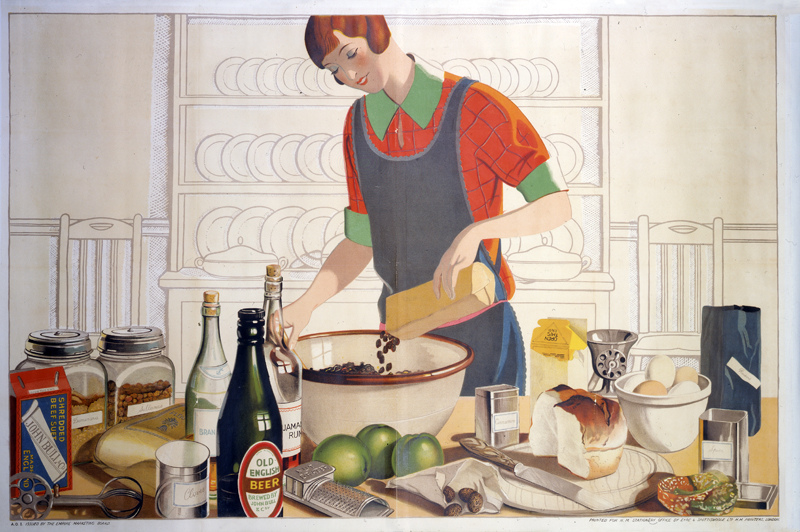
Here in the UK, Brits will munch their way through some 300 million mince pies over the festive period – but the sweet, rich, dried fruit mixture we are all used to filling our pies wasn’t always like that…. We can thank the Victorians for the version we know and love today….
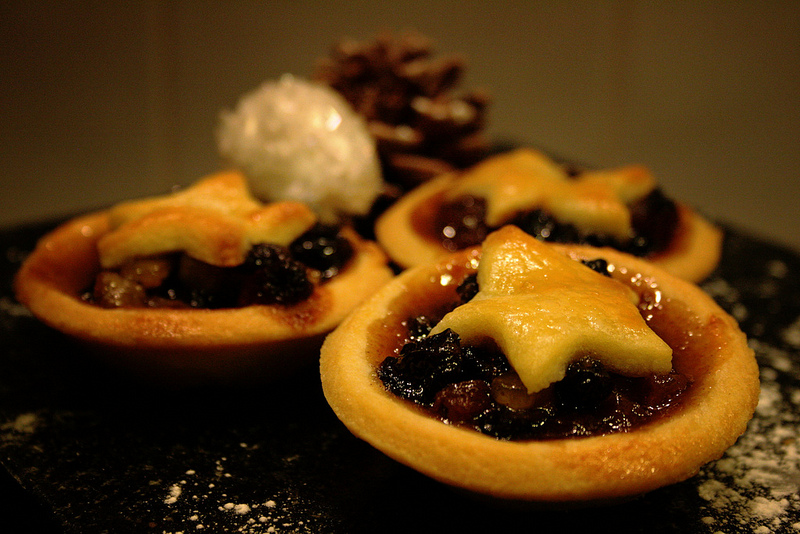
A clue to the beginnings of this confection is in the name – ‘mince’…. Other early names include ‘Mutton pie’, ‘Shrid pie’ and ‘Christmas pie’…. It is thought Crusaders returning from the Middle East brought home with them recipes and knowledge of Middle Eastern cookery – combinations of meat and dried fruits, laced with spices such as cinnamon, cloves and nutmeg…. Our Western interpretation gave us the original filling for the mince pie….using meat such as lamb. These first pies were usually formed into an oval shape to represent the crib of the Baby Jesus – sometimes a pastry baby would have decorated the top…. In time mince pies were to become a status symbol at the banquets of the wealthy – a chance to show off as to whose pastry chef could create the most elaborate, exciting shapes….
There was a belief in the Middle Ages that eating a mince pie on every one of the 12 days of Christmas brought wealth for the coming year…. (Really? Pass that plate of pies over here then)….

Our Christmas pudding also has its roots in the Middle Ages; it originates from a 14th Century pottage known as ‘Frumenty’. Made from beef, mutton, prunes, currants, raisins, wine and spices, its consistency was more of a soup. It was meant as a light meal and was eaten in the days leading up to the festive season – the idea being to prepare the body for the on-coming splurge of over-indulgence….
By the end of the 16th Century the porridge was evolving. By 1650, with the addition of eggs, oatmeal, beer, spirits and extra dried fruit, it had become reminiscent of the traditional pudding of the Christmas dinner we know today…. Once again it was the Victorians who adapted it into its now familiar form….
Before the 19th Century puddings were boiled in a cloth – it was the Victorians who began to put the mixture into bowls and moulds. By the 1830s most ordinary families would have had a traditional ball-shaped pudding – if it happened to be on the ‘heavy’ side it would have been jokingly referred to as a cannon ball…. Richer families may have enjoyed more elaborately shaped puds – moulded into shapes such as castles…. At this time Christmas pudding was also commonly known as Plum pudding – as the Victorians used ‘plum’ as another name for raisins….
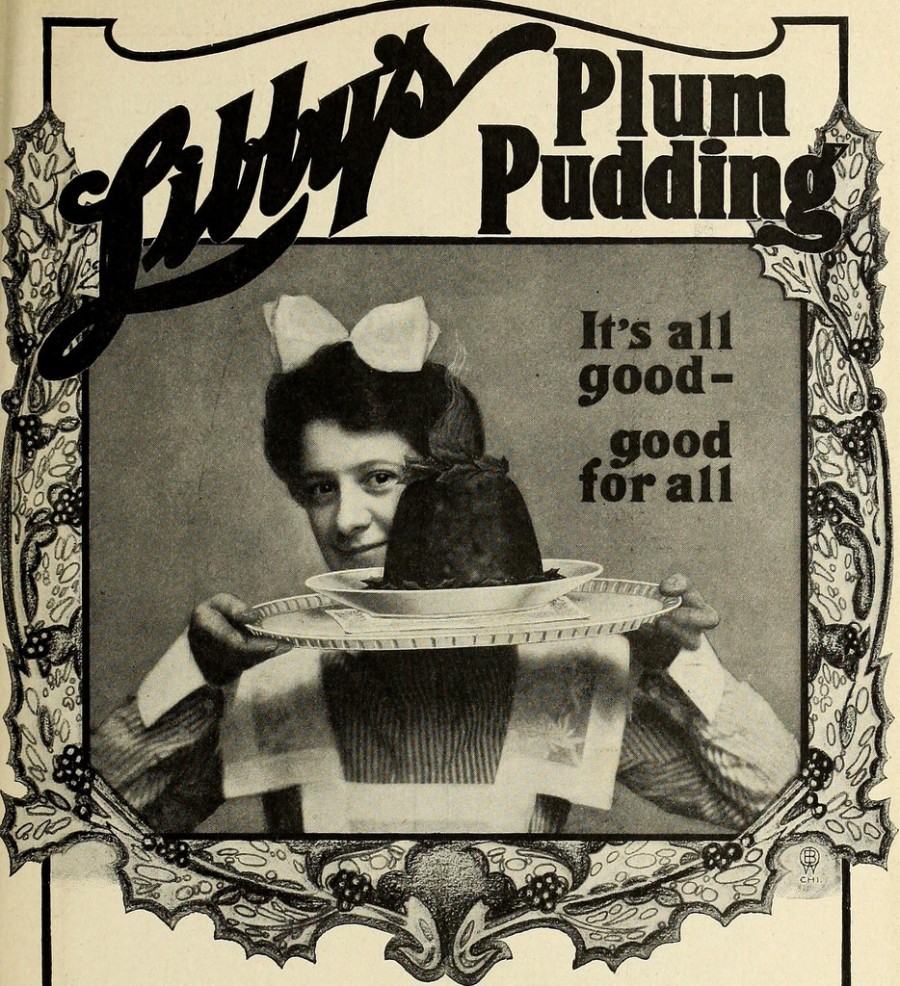
Of course, with the Christmas pudding comes a whole host of traditions and superstitions. One belief being that the pudding should be made on the Sunday before the beginning of Advent. To bring good fortune for the coming year each member of the family taking a turn to stir the mixture – from East to West – in recognition of the 3 Wise Men – making a wish as they did so…. It was thought the recipe should consist of 13 ingredients, one for Jesus and each of the 12 Disciples…. The tradition of placing holly on the top is a representation of the thorny crown worn by Jesus at the Crucifixion…. Brandy (or another spirit) poured over and set a flame – to show the power of the love of Jesus….


This Sunday became known as ‘Stir-up Sunday’ – taking its name from the obvious – but also from the Collect of the Book of Common Prayer for the Sunday before Advent….
“Stir up, we beseech thee, O Lord, the wills of thy faithful people, that they, plenteously bringing forth the fruit of good works, may by thee be plenteously rewarded, through Jesus Christ Our Lord, Amen”….
Then there are other traditions associated with the Christmas pudding – such as the hiding of a coin within it. This can be traced back to the eating of ‘Twelfth Night Cake’ during the early 1300s, when a dried pea or bean was placed inside the cake. The first coins to be hidden in our puddings were either a penny or silver farthing. Later it commonly became a threepenny bit but the one that will spring to mind for many of us is the sixpence. Nowadays, some families may still carry on the tradition; I expect a few £1 coins will find their way into this year’s puds….
In days gone by it wasn’t just the lucky coin that got popped into the pudding; other tokens were often added – a wishbone for luck; a button for a bachelor; a thimble for a spinster; a ring for someone soon to marry….
Nowadays, most of us buy our puddings ready-made – we spend approximately £48 million on them every year and some 25 million are consumed…. I wonder what Mary Kettilby – who in her 1714 book ‘A Collection of above Three Hundred Receipts in Cookery, Physick and Surgery’ shared the first known printed recipe for Christmas pudding – would have thought about that….
From the Christmas pudding comes our traditional Christmas cake…. During the 16th Century people began to save some of the pudding mixture, substituting the oatmeal for flour and adding eggs and butter to make a cake ready for Easter…. Richer families would decorate their cakes with marzipan and add spices to represent the exotic spices brought as gifts by the Wise Men. From these Easter fruit cakes evolved the Christmas cake….
Originally it was eaten on the 5th of January – ‘Epiphany’ and became a popular form of the Twelfth Night cake…. During the 1830s the focus changed from the 12th Night to Christmas Day itself…. Victorian bakers began to use icing to decorate the cakes with snowy scenes. Egg white icing dates back to the 1600s – but after its use on Queen Victoria’s wedding cake in the 1840s it became known as ‘Royal’ icing; this became the preferred icing on the Christmas cake – and so popular were they at Victorian gatherings by the 1870s we had the Christmas cakes we are familiar with today….


Again there are superstitions attached to the traditional Christmas cake…. It was thought to be unlucky to cut the cake before the dawn of Christmas Eve….and as with the mixing of the Christmas pudding ‘Stir-up Sunday’ rituals were observed…. Traditionally being made in November, the cake is then ‘fed’…. Small quantities of alcohol, usually sherry, brandy or whisky, added at regular intervals through small holes pierced into the un-iced cake….
Naturally, there are traditions that vary from region to region: in Yorkshire, for example, it is popular to eat Christmas cake with cheese! It may sound strange to some but since cheese and fruit compliment each other so well, it actually makes a perfect marriage…. Being a traditional winter cheese, Wensleydale is a good choice….
Scotland has its own traditional Christmas fruit cake – the renowned Dundee cake. It was in the Scottish eastern coastal city of Dundee that this cake was first commercially produced….
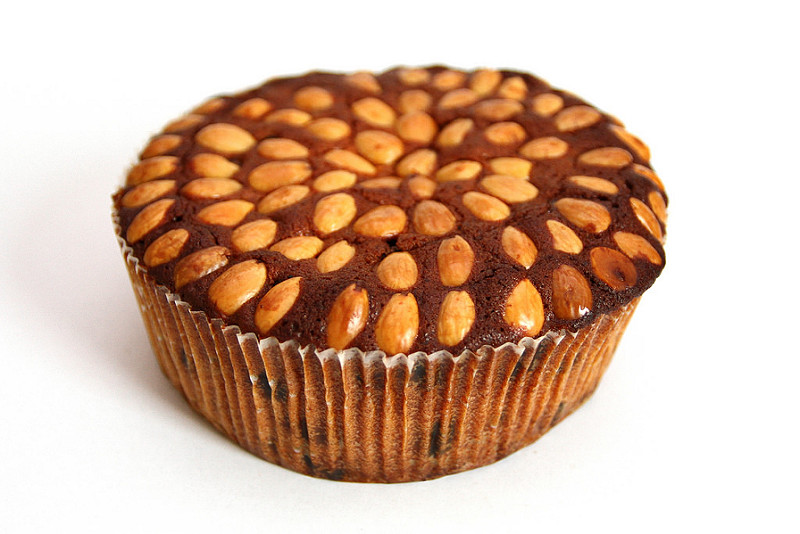
It is said the cake was first made for Mary Queen of Scots during the 16th Century – as she did not like cherries….and most fruit cakes of the day contained them…. Scottish bakers came up with the idea of using almonds instead….
A couple of hundred years later, during the 1760s, Janet Keiller was running her small shop in Seagate, Dundee – where she produced and sold confectionery and preserves…. The story goes that her husband, John, purchased a large quantity of Seville oranges; part of the cargo of a ship that had been forced into harbour to take shelter from a raging storm. The rather bitter fruit, not really suitable for every day eating, was passed its best and so Janet used the oranges by modifying an existing quince jam recipe. To it she added the shredded peel of the fruit, thus creating a new kind of marmalade…. (Marmalade comes from ‘marmelo’, meaning ‘quince’ in Portuguese)…. And so became the famous Keiller’s Dundee Marmalade – which took its place at so many a breakfast table….
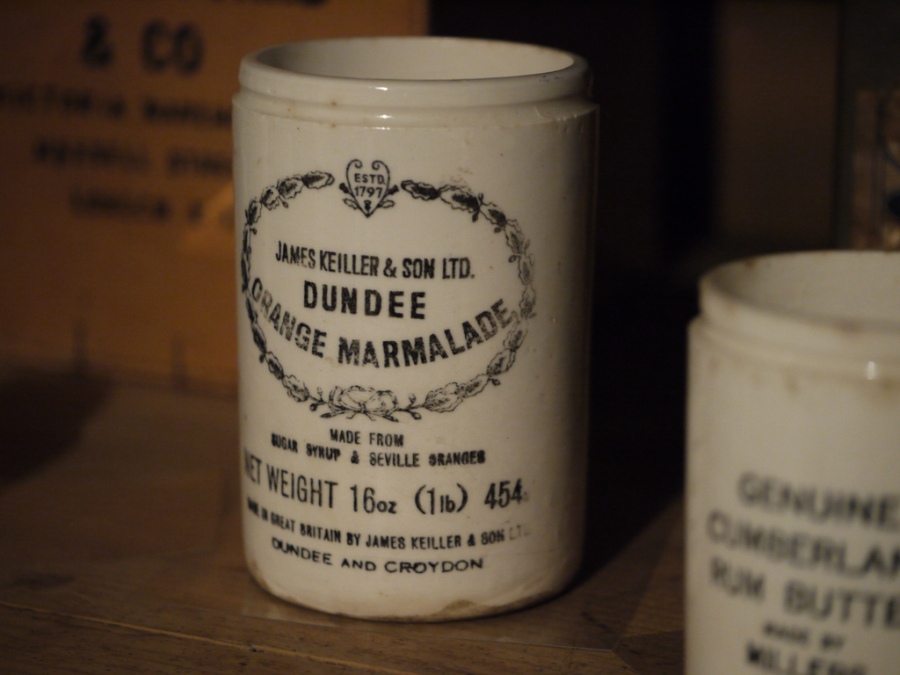
In 1797 Janet, then 60 years old, set up in business with her son, James, trading initially as James Keiller, changing to James Keiller and Son in 1804. Janet created a unique version of the Dundee cake – using their own candied orange peel and topping each cake with whole, blanched Spanish almonds. This was the first Dundee cake to be produced on a commercial scale….and was a massive success for the business. Even after the deaths of both her husband and son, Janet continued to run the Company with her daughter-in-law, Margaret…. So popular and in demand was the cake, that it was soon embraced by other bakers, both North and South of the border….
Understandably, the Scots are very proud of the heritage of this cake and are eager to protect its origins with a Protected Geographical Indicator (PGI). In November 2014 the then Scottish Food Secretary, Richard Lochhead MP, launched a national consultation. An application was made to the EU under the ‘Protected Food Name Scheme’, which covers regional and traditional foods where the origins and authenticity can be guaranteed. If satisfied that a particular food has the correct characteristics, reputation and quality to the area it has been named after, the EU can award a PGI mark…. So, fingers crossed for Dundee that their cake may attain the same status held by the likes of the Cornish pasty and Champagne….
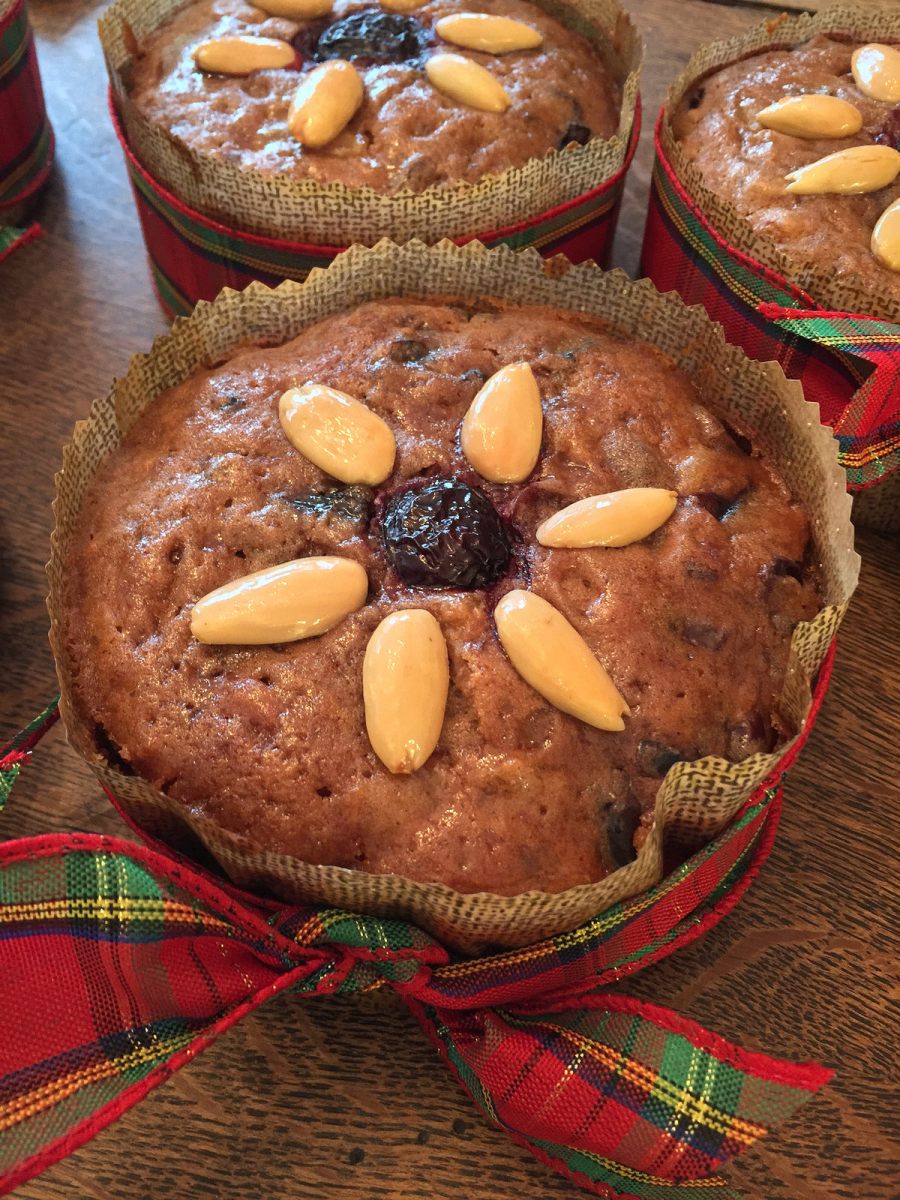
Dundee cake is not the only festive fare we associate with Scotland. Christmas time sees the shelves of our shops stacked with tartan packaging that contains the traditional delight that is shortbread…. The origins of Scottish shortbread comes from the Medieval ‘biscuit bread’. The word ‘biscuit’ literally means ‘cooked twice’. Left over dough from bread making was slowly dried out in the oven to make a hard rusk. Gradually, this evolved; the yeast was replaced by butter and shortbread as we know it came to be….


To start with shortbread was an expensive luxury and used only at special occasions; weddings, Christmas, New Year…. Especially New Year – being offered to ‘first footers’ – and for the Pagans – as Yule cakes; symbolising the Sun…. (We’ll come to the importance of Yule very shortly)….
Mary Queen of Scots once again makes an appearance in the history of Scottish baking – she was obviously a lady with a very sweet tooth…. Apparently she was particularly fond of Petticoat Tails – a thin, crispy, buttery shortbread – traditionally flavoured with caraway seeds…. If the Queen favoured something, naturally it was bound to catch on….
Another UK queen can be attributed to another popular biscuit of ours at Christmas time…. The Gingerbread Man….

Gingerbread dates to the 15th Century….but the first gingerbread figures can be documented to the Royal Court of Queen Elizabeth I in the 16th Century – when she had figures made to resemble her important quests to amuse them. In fact, she even had her own Royal Gingerbread Maker….
There was also a belief, among the Common-folk, that the ginger spice kept you warm in the winter, fighting those winter ails…(that’s a good enough excuse for eating ginger biscuits)…. Also, at this time, people believed in magic and witchcraft – some still do…. Gingerbread men were given to young women by witches and magicians as love tokens…. All the young woman had to do was get the man she desired to eat the gingerbread man that had been specially prepared for him – and then he would be hers….
“Run, run, fast as you can,
You can’t catch me, I’m the gingerbread man!”
-The Gingerbread Man – Nursery rhyme, 1800s
So, finally we come to the Yule log….
Burning the Yule log was originally a Nordic custom; Yule for the Winter Solstice…. The chosen log, or sometimes even a small tree, would ceremoniously be brought into the house – big enough to burn for the 12 days of Christmas. The largest end would be put into the hearth and then slowly fed in over the time – maybe it would be decorated with holly and ivy (to invite friendly sprites) and doused with cider or ale, before being left to smoulder for the 12 days…. Ash is the traditional wood, being a herb of the Sun; Ash brings light at the time of the Solstice…. Yule, when the dark half of the year gives way to the light – the shortest day comes to pass…. It also celebrates the rebirth of the Oak King – or Sun King…. The Yule log is the highlight of the Midwinter Solstice; it must have been harvested from the family’s own land – or at the very least given to them as a gift – never bought – money must never exchange hands…. Each year a piece of the log would be saved to light the next year’s Yule log…. The ashes from the burnt wood said to guard against evil and have medicinal properties; it was even thought to protect from lightning…. Spread upon the fields it promised a good future crop….
Traditionally in England, Oak was the chosen wood, in Scotland – Birch; whereas, in Devon and Somerset, huge bunches of Ash twigs were burnt instead of a log – symbolising the twigs gathered by the shepherds to warm Mary, Joseph and Baby Jesus….
Yuletide, Yulefest – eventually to become Christmastide – one of the many Pagan traditions hijacked by the Christian Church….
The actual Yule log cake possibly originates to the 1600s – sponge cake dates at least to 1615; the first known such recipe attributed to Gervaise Markham’s “The English Huswife”….
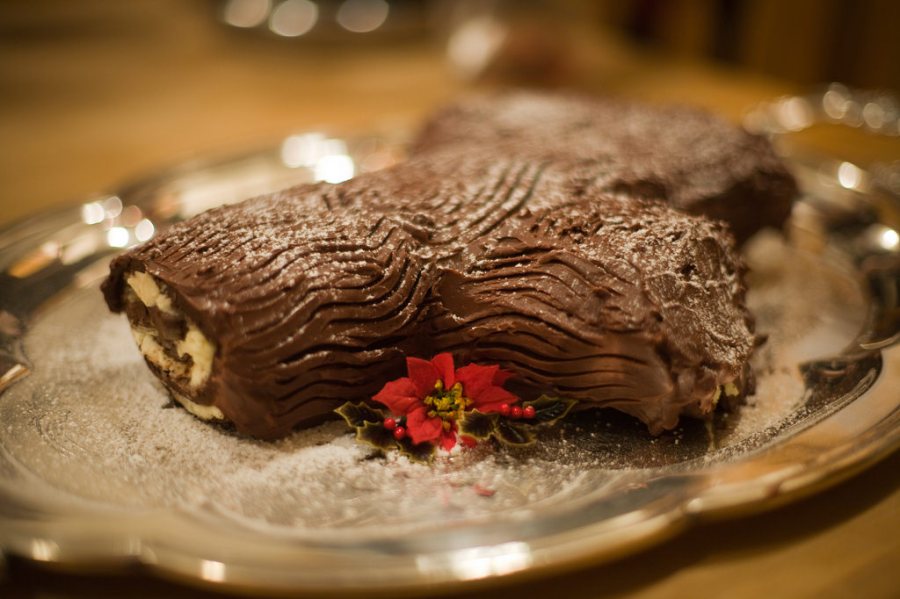
Nowadays, we all love that roulade, with its decadent chocolatey taste – along with all those other festive treats, that we may somewhat take for granted…. Did you know however, it is possible we are all technically breaking the law by indulging in them? On the 22nd December 1657, the Puritan Council of the biggest bah-humbug Christmas party-pooper of all time – one Oliver Cromwell – banned all Christmas festivities…. Nativity plays, carol singing, parties – all forbidden…. Mince pies, Christmas puddings, Yule logs – all became a definite ‘No No’…. In a bid to try and stop gluttony, one of the cardinal sins, these treats that we all enjoy so much, became illegal, as they were considered to be forbidden Pagan pleasures….
It is thought the laws were abolished when Charles II came to the Throne….although there are those who believe the laws still stand today – even though Royal approval was granted to the good old Christmas pud, when in 1714 King George I (the ‘Pudding King’) reinstated it as part of the Christmas meal….
Now, we Brits are always being told by ‘The Powers That Be’ that we’re all far too podgy and it’s not good for our health…. wouldn’t it be awful if our Government decided to reinforce some of those quaint, old, long-forgotten British laws in an attempt to make us all slimmer….? So, Ssshhh! Keep this quiet – we don’t want to go giving them any ideas… Go put the kettle on….let’s have that mince pie and a cup of tea….
Merry Christmas!! X



Wow! This was such a lovely post for many reasons. Thank you for seasonal writing taking the time to put this together.
This post is special to me because my mother was British; she was born in Edinburgh raised in Kent. She used to love mince! She also bought a yule log cake most years.
I went to England & Scotland this year for the first time! It was Sept/October and places around London were already taking reservations for Christmas!
And this year I plan to make an English Christmas for my parents in law and some other family members. My husband and I will be making sticky toffee pudding for the first time. For dinner we’re going to be having shephards pie but made with beef so it will be cottage pie.
Have you ever done crackers or poppers on holidays? I thought it would be fun to do this with everyone… I know my niece and nephew will like it.
Anyway, cheers to you and your English holiday post!! 🌟 🌲 🎅
LikeLiked by 1 person
Thank you for that lovely comment. I’m so glad you made it to the UK & had a good time. I spent part of my childhood in Kent, in a tiny village not far from Canterbury….it’s a lovely part of the Country.
Cottage Pie is a good choice for a real taste of England…make sure you put plenty of grated cheese on the top (Cheddar’s good if you can get it)….Yummy!!
Christmas crackers are a big part of Christmas over here… Nearly everyone has them… Most of them contain a paper hat (so we all sit looking daft around the table) – they have a small gift – usually something a bit ‘tacky’ but you can get some lovely crackers with really worthwhile things inside (it comes down to ‘you get what you pay for’)…. But, what our crackers are best known for is the terrible corny joke that each one usually contains… they always cause a few groans, ha ha! It’s all a good bit of fun… If you have the time it is lovely to be able to make your own crackers – then you can include little gifts that are personal to your friends and family…
Have a wonderful Christmas – and save me a bit of Sticky Toffee Pudding!!…. Oh yum!! Xx
LikeLike
Lovely post – and oh boy, you made my mouth water! This is the first year that I haven’t made a Christmas pudding but the other suspects are all around the house. There never seem to be enough mince pies, do there?
Thanks for doing the research for all your writing this year, Hazel. I’ve really enjoyed reading your blogs. Have a very Happy Christmas and delightful New Year xx
LikeLiked by 1 person
Thank you for all your lovely comments too – they are very encouraging to me… I’ve just completed my first year with the blog; in the beginning I wasn’t sure quite which way to go with it – initially I was going to concentrate on the renovation etc of this old place …. Things always tend to evolve though, don’t they? I remember saying I’m eager to see which path it takes me down, now I’m finding out…. I think it’s time to re-write the introduction page….
You have a terrific Christmas and New Year too – I’ve never met you but I have a strong suspicion you are a lady who knows how to make Christmas a very special time for everyone around you xxx
LikeLike
Thank you Hazel, that’s such a nice thing to say x Though I feel a bit of a fraud – I’m currently sitting in the living room playing scrabble with my two eldest daughters, doing my best to ignore the fact that my husband and youngest daughter are making profiteroles in the kitchen. Alex decided to make a croquembouche for Christmas lunch and they’re getting a head strart!
You’re so right about blogsites evolving. When I started it was purely to keep old friends and colleagues up to date with what we were doing but is now so much more than that.
Anyway, I must return to the scrabble board as I suspect some underhand play…
Have a lovely Christmas and a very Happy New Year xxx
LikeLiked by 1 person